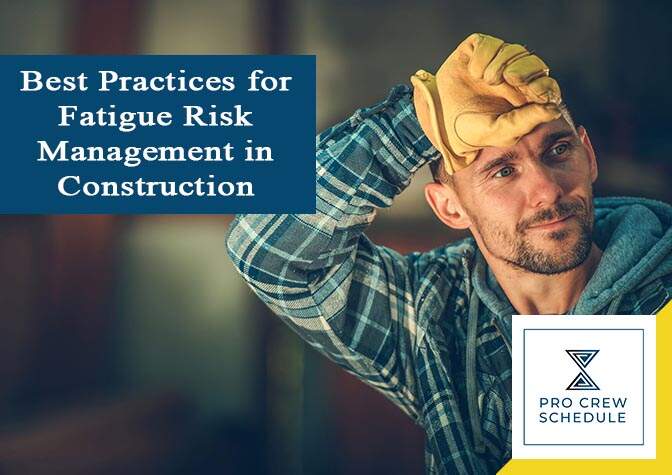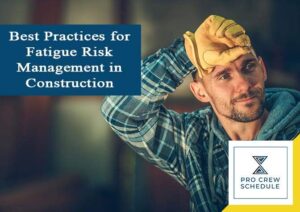A career in construction can be both satisfying and rewarding, giving excellent benefits and salary. However, the nature of the work can bring risks to the safety and health of the crew. Physically-demanding and time-consuming work create various risks for fatigue and other related injuries. Even varying job locations and very tight work schedules lead to irregular work hours, extended shifts and long commutes that trigger fatigue the most. Unfortunately, these are identified factors that make construction workers the most at-risk laborers among other industries as they continuously experienced burn out and exhaustion.
As an employer, it is crucial to be aware of the fatigue signs and implement effective ways to prevent it. Here are some of the best practices to follow to avoid construction worker fatigue.
What is Worker Fatigue?
Worker fatigue is one of the many things that is often ignored on the construction site. Whether physical or mental, fatigue can impair the worker’s ability to effectively and safely perform their duties. It also can increase the risks of injuries and accidents that can lead to expensive compensation costs. In simplest terms, fatigue occurs when the person’s energy is low. It can either be mental or physical or a combination of two. In the construction industry, it is estimated that fatigue is a contributing factor in the injuries and accidents that happened today.
That is why it is essential to minimize worker fatigue on the construction site. With safety as the main priority, employers can implement practical steps and practices to limit incidents related to fatigue and also to maintain the level of situational awareness on-site.
Here are some common signs of worker fatigue to observe on-site.
- Inability to concentrate and focus
- Slowing reaction times and reflexes
- Repeated yawning
- Loss of stamina and strength
- Nodding off at work
- Difficulty communicating and collaborating
- Needing more frequent breaks
- Blurry vision
- Declining work productivity
- Feeling lightheaded and having frequent headaches.
- Showing poor decision-making and judgment
- Less motivated, engaged, and committed to everyday work
- · Less participative and struggling to remember work-related things
- Sick days tend to increase.
- Lesser social participation with other crew members.
Other many different factors cause health risks to the workers. It is sad to say that the construction industry is a high-risk, high-effort, and high-stress environment leading to worker fatigue. Construction workers are also commonly exposed to other dangers like extreme noise, chemicals, and hazardous materials. While workers might be protected from the hazards because of wearable PPEs, it still adds additional work strain. Overall, construction is very demanding, physically and mentally. If not appropriately managed or prevented quickly, it can significantly affect everyone’s health on-site.
Preventing Worker Fatigue in Construction
Fatigue affects every crew’s performance on the construction site in different ways. Therefore, it is the job of employers first to educate construction workers about fatigue and its common risks. They ought to find many ways and implement them on-site to determine, prevent, and lessen workers’ fatigue risks. They also have to consider deploying construction crew management to supervise each crew better.
The good thing is that fatigue can be effectively prevented, mainly when there is increase awareness of the warning signs. For employers, it is crucial to monitor the workload and performance of every crew on-site. Below are some helpful recommendations and tips to follow:
Employers:
- Establishing fatigue management into every planning stage of the job.
- Arrange the work schedules to provide enough rest opportunities for everybody involved.
- · Limit the number of repeated shifts in terms of night work.
- Consider shorter night work schedules.
- Require a minimum number of working hours. It should be before working for the next shift right after working ten hours or more.
- Train workers about safety risks, particularly for fatigue, and how to distinguish it.
- · Provide a better way for construction workers to tell any problematic work schedules anonymously.
- Include fatigue in root cause surveys following any on-site incidents.
- Implement procedures to manage and monitor fatigue risks
- Never set unrealistic productivity goals that push the workers too hard.
- Vary each crew’s tasks and activities to avoid extended periods of physically demanding and repetitive work.
- Make sure the job sites are safe and well-lit during early mornings and evenings.
- · Have on-site project managers monitor workers for any signs of fatigue using project management tools.
- Provide consistent opportunities for all workers to warm up or cool off during cold and hot weather.
Workers:
- Follow any near-miss and other reporting policies at your employers.
- Use off time more responsibly to obtain enough rest and fitness when on the job.
- · Take steps to make better sleep and protect it.
- Maintain a regular and consistent sleep schedule.
- Set a goal to get at least 7 hours of sleep that will not change and supplement with naps.
- · Avoid drinking alcohol and caffeine before sleep.
- Make changes and some adjustments in the sleeping area.
- Look for early signs of fatigue like fidgeting, staring blankly and rubbing off the eyes.
- · Start each workday with an energizing and nutritious breakfast.
- Stay well-hydrated and active by drinking water continually.
- Have a quick, healthy snack to boost energy
Additionally, it is vital to have a culture that supports worker wellness and allows the entire crew to communicate professional and personal issues openly. If the work environment and the people around provide support to one another and cooperate, fatigue risks are lessened. Employers should bear in mind that the crew is the most valuable asset in the company.
Implementing Fatigue Risk Management System (FRMS) Onsite
An FRM is a set of guidelines and procedures utilized to reduce fatigue risks and the massive impact on the worker’s productivity. It is also defined as a program purposely crafted to minimize workplace hazards directly related to worker fatigue. On the other hand, a fatigue management system includes the following:
- A set of policies address how will handle worker fatigue appropriately.
- · A set of procedures lessen the likelihood of worker fatigue.
- Methods and strategies for determining if the worker is under stress or experiencing fatigue
- An education program for all that discusses fatigue’s threats and dangers – how to identify it, correct it, and what can make workstyle adjustments to prevent it.
- Identify, change, examine, and manage any fatigue factors related to labor productivity.
- Establish fatigue-focused policies
- Investigate fatigue-related causes and effects in any incidents
- Require education and training on the prevention and dangers of sleep-related errors.
- Improve as necessary.
In conducting a risk assessment, employers and project leaders have to know the entire process. This assessment is a process that is similar to completing any hazard assessments, yet, it focuses solely on the possibility of injuries resulting from fatigue. The leaders have to start considering some factors that have been placing workers at increased fatigue risk. All activities designated for every crew can be considered as a risk factor for fatigue. Also, the individual work experiences of every worker is also a possible factor. By conducting a survey, this assessment is easily accomplished. Make sure to engage everyone in a discussion about fatigue.
Overall, fatigue management systems are practically essential to implement since they allow workers to take sufficient rest to keep them more productive. On the contrary, bad, poor, and below construction labor productivity often hinders efficient construction planning. It only means that there can also be a failure in various functional areas, including timeline task completion, employee company profits, and worker performance. But FRMS is one right solution to solve such issues.
Construction Scheduling Software Helps Minimize Labor Productivity Issues
Even when employers, project leaders, and contractors seek to fix worker fatigue via an informal system, an application and access to advanced software tools designed for project management purposes are entirely different. It is more likely beneficial and helpful for the teams in terms of productivity, saving time, and increasing returns. It is crucial to deploy efficient construction management software to stay ahead of the game. But the real thing is, this advanced software tool can reduce labor productivity issues caused by worker fatigue.
Below are the many benefits this particular software offers to the workers and employers as the construction team continues to combat fatigue issues.
- Real-time collaboration and communication
- Planning more efficient work schedules and better managing construction.
- Ensuring sufficient staffing and operations.
- Managing automated employee training
- The crew’s activities are time-tracked.
- The worker’s performance is observed, monitored, and well-supervised.
- Automated employee training is efficiently managed.
- Effective tasks delegation
- Easier integration of new members
- Budget and resource management
- Easier file sharing and document access
Additionally, the construction manager can conveniently create a project management plan that prioritizes tasks for every crew member using this software. Several tasks like identifying independencies, creating project deliverables, and setting up deadlines can be completed quickly within no time. Indeed, useful construction management tools come with features that help in streamlining the entire process.
Key Takeaways
Employers are generally obligated to keep their workers safe and healthy. Take note that worker fatigue is a very serious health issue that must not be overlooked. Overall, it isn’t just taking a toll on the worker’s health or lead to severe injuries on the construction site; it can also be costly for the employers because they are obligated to shoulder the expenses if something wrong might happen on-site.







